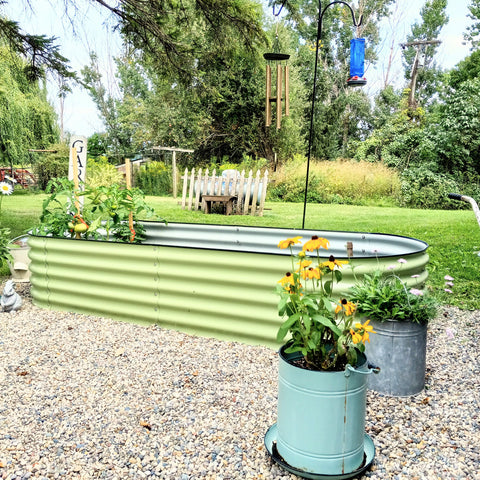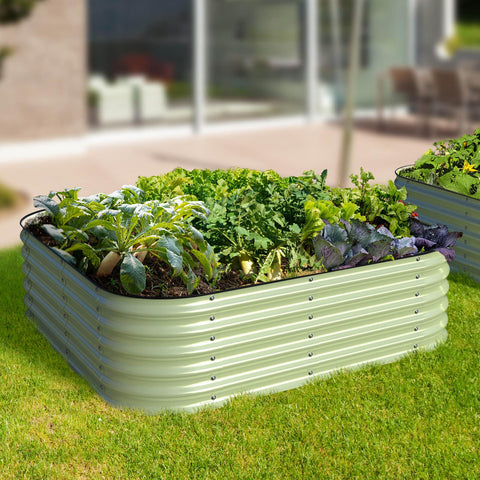Knowledge from Olle Garden Bed: How Is Gardening Done
We will look at how to create an outdoor garden because most people will expect it. The following content also has some reference value for raised garden beds.

1. Before you start, find out your hardy zone!
Hardy zones are standards developed by the U.S. Department of Agriculture to help gardeners and anyone else interested in growing plants make them aware of the plants most likely to grow and thrive where they live. This means that some plants are most likely to succeed in certain parts of the United States, while others are not.
When you look at the map of the hardy zones, you'll notice that each zone differs from the next by 10°F (about 5,5°C). Each zone is then divided into zones A and B, which differ from each other by 5°F (2,7°C).
Why care about hardy zones?
USDA hardy zones determine the average minimum temperature each zone will receive. So, you can decide on perennials and perennials in your area depending on your location, and what are annuals with the help of this.
For example, one way to ensure your success in your endeavors is to ask other growers in your area!
2. What are the best tips for gardening beginners – start small!
If you're new to this activity, we highly recommend starting small. So, just start with a little plot or garden bed because you don't want to bite more than you can chew.
3. Choose a good website
You'll want to make sure you choose a location that matches how the sun rises and sets. You want your garden bed or garden to face in the same direction to get as much sun as possible. For example, vegetables need at least six hours of sunlight a day.
If you live in the Northern Hemisphere, you want to locate garden beds from north to south. This will allow the plant to get the maximum exposure needed for sunlight. In addition, orienting plants from north to south in the northern hemisphere will allow more air circulation, which is very useful for pollination.
You want to make sure you grow the tallest plants in the northern direction of the Northern Hemisphere. This will prevent them from blocking shorter plants from getting sunlight.
But what if I live in the Southern Hemisphere?
If you live in the Southern Hemisphere and you want to orient your plants from east to west, give them these conditions. In addition to this, you may want to make sure to plant tall plants in a south-facing direction to prevent them from blocking dwarf plants from getting sunlight.
Finally, make sure your garden bed is not near any tall trees or fences. This is because when the sun rises, these tall fences or trees form sun blinds that cover your plants and prevent them from getting sunlight.
4. Choose your water source
You want to make sure your water source is close to your garden bed. When you water your plants, this can save you a lot of time and effort. If your water source is far from plants, you can use a hose as an irrigation system.

5. Your soil matters
An important factor for successful growth is soils rich in nutrients, organic matter, water and organisms (macroscopic and microbial). To ensure this, you can do a soil test. With a soil test, you will determine what your soil lacks and what it has.
After the soil test, the next step is to prepare the soil. Soil preparation is an essential step because:
1. You can get rid of any weeds.
2. You can also add more nutrients to the soil.
3. It helps to improve soil water cycle and efficiency.
4. It helps loosen the ground so that the roots of the plant grow efficiently.
You can use many tools such as wide forks, cultivators, or digging forks for land preparation. For example, you can use a digging fork or a wide fork to prepare less compact soil. However, if your soil is "dense", then it is better to use a tillerer.
6. Add nutrients
Once you've loosened the soil through preparation, you'll want to add some organic compost to the ground. This is done because it helps replenish lost nutrients and improves soil quality. This is one of the main reasons we fertilize our plants!
7. It's time to build your garden bed
An easy way to do this is to determine where you want your garden bed and path. To do this, move the dirt on the path to the garden bed until the height of the garden bed is between 6 – 11 inches (15 – 28 cm).
When your bed is at your preferred height, you need to make sure that the bed is graded. If you notice from soil testing that your soil lacks any nutrients, you can use fertilizers (organic or inorganic) to add the required nutrients.
8. It's time to control the weeds
One of the best ways to prevent weeds from growing in your garden bed is to place cardboard on your trails and water them to make sure they stick to the soil. After that, cover the cardboard with some straws.
After that, water the plant for a few minutes, triggering weed growth on the bed. Therefore, after a few days or weeks, remove any seedlings growing on the soil bed. This is a good thing to do at least two weeks before sowing.
9. Planting time
The next obvious step is to grow your favorite flowers, vegetables, fruits, or herbs after weed control is complete. Depending on the type of plant you want to grow, the planting method may vary. But, again, this means that you need to do some research to successfully grow your favorite plants.
10. Stop intruders
If you are in an area where rabbits, deer, or some other animal can break into your garden, then you may need to build a fence or other barrier to prevent these animals from ruining your hard work. That's it! Now you have a garden!
